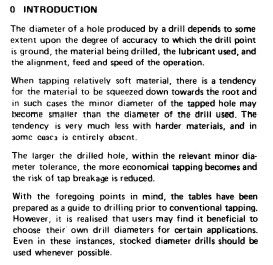Mark,
I can see where you are coming from. The problem is everyone is assuming a 6.8mm drill is too small. In fact perhaps we are all right.
Kennametal say:
"Suggested Percentages of Full Thread in Tapped Holes
A common internal thread, drilled so that it results in 50% of full thread will break the external thread, before the internal thread will strip. A common internal thread drilled out so that it contains 100% of full thread is only 5% stronger than a 75% height of thread, yet it requires 3 times the power to tap."
This is what Guhring say:
"Percentage of Thread and Tap Drill Selection:
Many variables affect the performance of threaded holes and the taps used to generate them. One very important factor is the drill size used to produce the hole that will be tapped. Most tap drill charts call out only one tap drill size, and that will produce an approximate 75 percent thread. In general, tap tool life can be increased significantly by using a lower percent of thread and we suggest using values between 60% and 70% for most applications. Thread strength is not directly proportional to percent of thread. For example a 100% thread specification is only 5% stronger than a 75% thread specification but requires 3 times the torque to produce.
Metric threads of the International Standards Organization (ISO) have the same 60-degree thread form as UN threads, though the diameters and pitches are not interchangeable. Metric tap drill charts have the same drill size problem in that they use the same formula as that employed for the obsolete AS threads. In both ISO and UN thread series, having a range of useful drill sizes allows designers and machinists to tailor effective thread depth for long holes, various materials and thread strength requirements. It also allows for the combining of inch and metric taps and drills where convenient to do so. "
Together with a useful drill size calculator: http://www.guhring.com/Tech/TapDrill/
So Kennametal sing the praises of 50% engagement and even Guhring's 60% is outside DIN specification.
Dormer's view is more conservative, they recommend a 6.8mm drill for M8 with the proviso that is you use one of their advanced rill bits that has less of a tendency to cut oversize, you should use a 6.9mm drill. In other words they expect a normal 6.8mm drill to make a hole at least 6.9mm in diameter…
Sandvik Coromant remind us:
Thread height in %, is the ratio between actual height and maximum height of the internal thread. The example below applies to ISO & UTS standard – 60° threads.
Example, M8x1,25
Maximum thread height according to standard is 6/8 H.
H = 0.866 x P
(H = Basic triangle height)
(P = thread pitch)
Maximum thread height is:
6/8 * (0.866 x 1, 25) = 0.811 mm
Actual thread height at a core hole of Ø6.9 mm:
(8 – 6,9) / 2 = 0.55 mm
Thread height is then (0.55 / 0.81) x 100 = 68%
I think, perhaps, we have lost sight of the fact that a 6.8 hole only provides 74% engagement, and that a 6.9mm hole is only 68% thread engagement, and closer to what most of us will get with a 6.8mm drill.
That 6.9mm hole with 68% engagement is within DIN specification.
Finally Fuller are erring on the side of caution and broken taps – they recommend a 6.75mm drill but warn that "All information is strictly informative".
Me? Now I'm fully informed I'll probably use a 7mm drill knowing that the 61% engagement will strip the external thread before it fails, with a safety margin* 
Neil
*Just as well as most of use would rather replace a stripped stud than fix a stripped out hole in a workpiece.
<edited for typos>
Edited By Neil Wyatt on 12/10/2016 20:02:15
Mark C.


.jpg)







